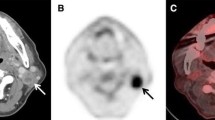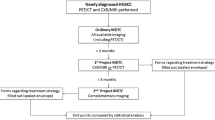Abstract
Objectives
We assessed whether quantitative imaging biomarkers derived from fluorodeoxyglucose-positron emission tomography (18F-FDG PET) could be extracted from perineural spread (PNS) in head and neck malignancies (HNM) to improve patient risk stratification.
Methods
A case–control exploratory study (1:2 ratio) enrolled 81 patients with FDG-avid HNM. The case-group comprised 28 patients with documented PNS (reference: expert consensus), including 14 squamous cell carcinomas (SCC). Imaging biomarkers were extracted from the PNS on 18F-FDG PET, CT-scan, and MRI. The control-group enrolled 53 SCCs. The Cox proportional-hazards regression model explored the association with overall survival by univariate and multivariate analyses.
Results
The rate of PNS detection by 18F-FDG PET was 100% in the case-group. Quantitative imaging biomarkers were not associated with the presence of sensory (p>0.20) or motor (p>0.10) symptoms. In SCC patients (case: 14; control: 53), PNS was associated with a hazard ratio of death of 5.5 (95%CI: 1.4:20.9) by multivariate analysis. Increased cranial nerve SUVmax was significantly associated with poorer overall survival by univariate analysis (p=0.001).
Conclusions
Our pilot study showed the feasibility of extracting 18F-FDG PET biomarkers from PNS in FDG-avid HNM. Our results encourage the development of new PET/CT- or PET/MRI-guided management strategies in further prospective studies.
Key Points
• 18F-FDG PET/CT detects PNS in FDG-avid HNM.
• PNS metabolism is more heterogeneous than healthy tissue.
• PNS diagnosis is crucial: most patients were asymptomatic, N0 and M0.
• PNS diagnosis is associated with poorer overall survival in SCC.
• PET/CT- or PET/MRI-guided management strategies should be evaluated.






Similar content being viewed by others
Abbreviations
- PNS:
-
Perineural spread
- SUV:
-
Standardised uptake value
- HISUV:
-
Heterogeneity index of the standardised uptake value
- V1 :
-
Ophthalmic branch of the trigeminal nerve
- V2 :
-
Maxillary branch of the trigeminal nerve
- V3 :
-
Mandibular branch of the trigeminal nerve
- VII:
-
Facial nerve
References
Trotta BM, Pease CS, Rasamny JJ, Raghavan P, Mukherjee S (2011) Oral cavity and oropharyngeal squamous cell cancer: key imaging findings for staging and treatment planning. RadioGraphics 31:339–354
Wahl RL, Jacene H, Kasamon Y, Lodge MA (2009) From RECIST to PERCIST: evolving considerations for PET response criteria in solid tumors. J Nucl Med 50:122S–150S
Dercle L, Chisin R, Ammari S et al (2015) Nonsurgical giant cell tumour of the tendon sheath or of the diffuse type: are MRI or 18F-FDG PET/CT able to provide an accurate prediction of long-term outcome? Eur J Nucl Med Mol Imaging 42:397–408
Dercle L, Seban RD, Lazarovici J et al (2017) 18F-FDG PET and CT-scan Detect New Imaging Patterns of Response and Progression in Patients with Hodgkin Lymphoma Treated by Anti-PD1 Immune Checkpoint Inhibitor. J Nucl Med. https://doi.org/10.2967/jnumed.117.193011
Balink H, de Visscher JG, van der Meij EH (2014) Recurrent head and neck desmoplastic melanoma with perineural spread along the nervus mandibularis revealed by 18F-FDG PET/CT. Int J Oral Maxillofac Surg 43:941–943
Paes FM, Singer AD, Checkver AN, Palmquist RA, La Vega GD, Sidani C (2013) Perineural spread in head and neck malignancies: clinical significance and evaluation with 18F-FDG PET/CT. RadioGraphics 33:1717–1736
Nguyen BD, Roarke MC (2008) Salivary duct carcinoma with perineural spread to facial canal: F-18 FDG PET/CT detection. Clin Nucl Med 33:925–928
Lee TJ, Glastonbury CM, Buckley AF, Eisele DW, Hawkins RA (2008) Perineural spread of melanoma demonstrated by F-18 FDG PET With MRI and pathologic correlation. Clin Nucl Med 33:106–108
Conrad GR, Sinha P, Holzhauer M (2004) Perineural spread of skin carcinoma to the base of the skull: detection with FDG PET and CT fusion. Clin Nucl Med 29:717–719
Fosko SW, Hu W, Cook TF, Lowe VJ (2003) Positron emission tomography for basal cell carcinoma of the head and neck. Arch Dermatol 139:1141–1146
Sekine T, BARBOSA F, Delso G et al (2016) Resectability assessment of head and neck cancer-PET/MR versus PET/CT. J Nucl Med 57:625–625
Schaarschmidt BM, Heusch P, Buchbender C et al (2016) Locoregional tumour evaluation of squamous cell carcinoma in the head and neck area: a comparison between MRI, PET/CT and integrated PET/MRI. Eur J Nucl Med Mol Imaging 43:92–102
Kuhn FP, Hullner M, Mader CE et al (2014) Contrast-enhanced PET/MR imaging versus contrast-enhanced PET/CT in head and neck cancer: how much MR information is needed? J Nucl Med 55:551–558
Rodrigues RS, Bozza FA, Christian PE et al (2009) Comparison of whole-body PET/CT, dedicated high-resolution head and neck PET/CT, and contrast-enhanced CT in preoperative staging of clinically M0 squamous cell carcinoma of the head and neck. J Nucl Med 50:1205–1213
Nemec SF, Herneth AM, Czerny C (2007) Perineural tumor spread in malignant head and neck tumors. Top Magn Reson Imaging 18:467–471
Caldemeyer KS, Mathews VP, Righi PD, Smith RR (1998) Imaging features and clinical significance of perineural spread or extension of head and neck tumors. RadioGraphics 18:97–110 quiz 147
Parker GD, Harnsberger HR (1991) Clinical-radiologic issues in perineural tumor spread of malignant diseases of the extracranial head and neck. RadioGraphics 11:383–399
Gandhi D, Gujar S, Mukherji SK (2004) Magnetic resonance imaging of perineural spread of head and neck malignancies. Top Magn Reson Imaging 15:79–85
Sachpekidis C, Larribere L, Pan L, Haberkorn U, Dimitrakopoulou-Strauss A, Hassel JC (2015) Predictive value of early 18F-FDG PET/CT studies for treatment response evaluation to ipilimumab in metastatic melanoma: preliminary results of an ongoing study. Eur J Nucl Med Mol Imaging 42:386–396
Ginsberg LE (1999) Imaging of perineural tumor spread in head and neck cancer. Seminars in Ultrasound, CT and MRI. Elsevier, pp 175-186
Nemzek WR, Hecht S, Gandour-Edwards R, Donald P, McKennan K (1998) Perineural spread of head and neck tumors: how accurate is MR imaging? Am J Neuroradiol 19:701–706
Caldemeyer KS, Mathews VP, Righi PD, Smith RR (1998) Imaging features and clinical significance of perineural spread or extension of head and neck tumors. RadioGraphics 18:97–110
Nemzek WR, Hecht S, Gandour-Edwards R, Donald P, McKennan K (1998) Perineural spread of head and neck tumors: how accurate is MR imaging? AJNR Am J Neuroradiol 19:701–706
Ogino S, Stampfer M (2010) Lifestyle factors and microsatellite instability in colorectal cancer: the evolving field of molecular pathological epidemiology. J Natl Cancer Inst 102:365–367
Ogino S, Goel A (2008) Molecular classification and correlates in colorectal cancer. J Mol Diagn 10:13–27
Ogino S, Chan AT, Fuchs CS, Giovannucci E (2011) Molecular pathological epidemiology of colorectal neoplasia: an emerging transdisciplinary and interdisciplinary field. Gut 60:397–411
Dercle L, Ammari S, Bateson M et al (2017) Limits of radiomic-based entropy as a surrogate of tumor heterogeneity: ROI-area, acquisition protocol and tissue site exert substantial influence. Sci Rep 7:7952
Dean NR, White HN, Carter DS et al (2010) Outcomes following temporal bone resection. Laryngoscope 120:1516–1522
Brahme A (1988) Optimization of stationary and moving beam radiation therapy techniques. Radiother Oncol 12:129–140
Yu CX, Tang G (2011) Intensity-modulated arc therapy: principles, technologies and clinical implementation. Phys Med Biol 56:R31–R54
Johnston M, Yu E, Kim J (2012) Perineural invasion and spread in head and neck cancer. Expert Rev Anticancer Ther 12:359–371
Soto DE, Kessler ML, Piert M, Eisbruch A (2008) Correlation between pretreatment FDG-PET biological target volume and anatomical location of failure after radiation therapy for head and neck cancers. Radiother Oncol 89:13–18
Halbrook CJ, Lyssiotis CA (2017) Employing Metabolism to Improve the Diagnosis and Treatment of Pancreatic Cancer. Cancer Cell 31:5–19
Vander Heiden MG, Cantley LC, Thompson CB (2009) Understanding the Warburg effect: the metabolic requirements of cell proliferation. Science 324:1029–1033
Funding
Laurent Dercle is funded by Fondation Philanthropia (Geneva, Switzerland) and the ARC Foundation (Villejuif, France).
Author information
Authors and Affiliations
Corresponding author
Ethics declarations
Guarantor
The scientific guarantor of this publication is Laurent Dercle.
Conflict of interest
The authors of this manuscript declare no relationships with any companies whose products or services may be related to the subject matter of the article.
Statistics and biometry
One of the authors has significant statistical expertise, and no complex statistical methods were necessary for this paper.
Informed consent
Written informed consent was waived by the institutional review board.
Ethical approval
Institutional review board approval was obtained.
Methodology
Retrospective case–control study, performed at one institution
Rights and permissions
About this article
Cite this article
Dercle, L., Hartl, D., Rozenblum-Beddok, L. et al. Diagnostic and prognostic value of 18F-FDG PET, CT, and MRI in perineural spread of head and neck malignancies. Eur Radiol 28, 1761–1770 (2018). https://doi.org/10.1007/s00330-017-5063-x
Received:
Revised:
Accepted:
Published:
Issue Date:
DOI: https://doi.org/10.1007/s00330-017-5063-x




